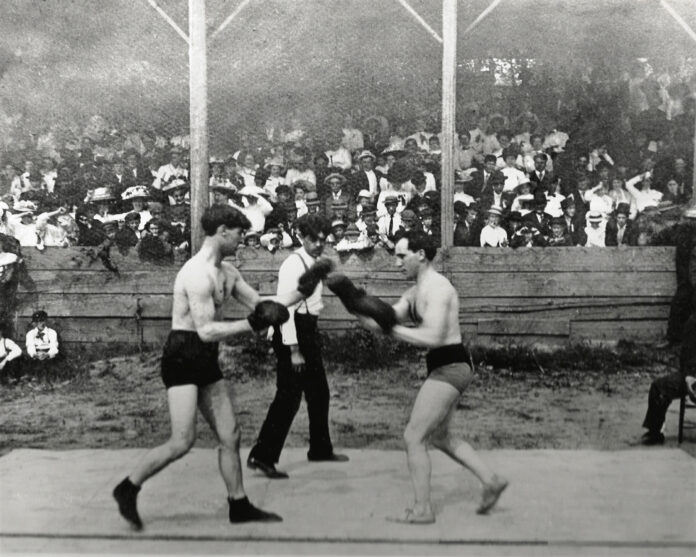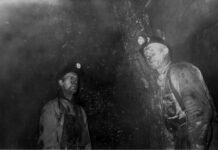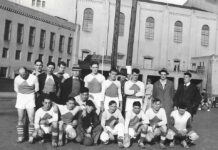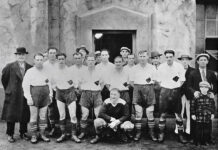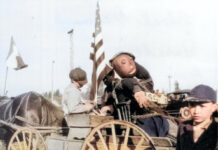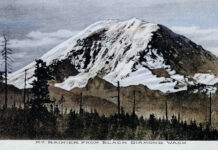By the early 1920s, leisure time in America grew as the 40-hour work week became dominant in most industries due to large increases in productivity through industrialization and the movement of people from farms to cities. Fresh from victory in the First World War, the economy boomed and spectator sports offered options for what to do with those extra hours.
The two most popular sports were boxing and baseball. Football was still considered brutal after multiple deaths caused newspaper headlines in the early 1900s. Basketball wasn’t invented until 1891. Soccer was primarily a sport for European immigrants and its popularity fell as football and basketball gained new adherents. Tennis, golf, and polo were considered elitist and generally relegated to country clubs.
In mining towns like Black Diamond with large ethnic populations, baseball, boxing, and soccer were the top sporting events. This 1921 photo features a boxing match, or smoker between Gomer Evans Sr., champion of the coal mine fire-bosses, on the left and John Emanuel, a retired middleweight on the right. The match was refereed by George Ayers, center, in front of a large crowd at the Black Diamond baseball field grandstands. A quick glance at those attending, suggests the sport was almost as popular with women as it was with men.
Evans’ son, Gomer Evans Jr. was born six years later, in 1927. He lived a storied life that saw him participate in Black Diamond’s city incorporation, then became the youngest council member, later served as Chief of Police and Mayor, and was often credited with knowing where every water pipe in town was laid.
A sports story in the Oct. 24, 1921, Pacific Coast Bulletin described the three-round smoker that took place on the Friday evening ten days earlier. “Gomer, on account of his long reach, was successful in hitting the referee first and almost copped the decision, but John overcame his lead in the last stanza and the bout was declared a draw.” A wrestling match was the first item on the evening’s card and featured an event between Ted Brown and Ralph Witmer that lasted 27 minutes before Brown pinned his opponent. A final three-round boxing bout between two brothers, William and Leonard Berry followed with the elder Berry, Bill gaining the edge.
Other prominent Black Diamond fighters included George Ayers, who refereed the 1921 Evans-Emanuel match, John Babchanik, Brenmauer Emanuel, Casper Erath, Jack Jackson, John ‘Cut’ Kravagna, John Maks, Emmett McIntyre, Alfred Moore, John Richter, Louis Santi, Vern Stewart, Charles Thompson, Rome Vernarelli, and most notably Carl Steiert the founder of the Black Diamond Historical Society.
Much of the research for this column was provided by JoAnne Matsumura, an Issaquah historian who owns and has access to a wide variety of historical documents. Among Matsumura’s collections are past issues of the Pacific Coast Bulletin, an employee newsletter distributed to the miners, rail workers, and seagoing employees of Pacific Coast Company which owned coal mines, railroads, ports, and steamships.
The first issue of the Bulletin was published in Jan. 1914, with versions written in several different languages for employees who didn’t speak English. A new series began in March–April 1916 and continued until the bitter miners’ strike of 1919 and company lockout of 1921. Those labor wars literally tore apart Black Diamond resulting in the nearby village of Morganville built by the labor union to house displaced workers.
The final series of Pacific Coast Bulletins began on Oct. 4, 1921 and continued until March 1931. The inaugural issue of the final series featured an introduction that detailed the newsletter’s mission: “The columns of the Bulletin will be devoted chiefly . . . to the affairs of The Pacific Coast Coal Company, its new organization of men at the mines, their associates and employers,” then continued, “Every man in the Company is hereby appointed a special correspondent of the publication, with the full authority to send in such items of news or interest as he may deem helpful.”
This photo comes courtesy of the Black Diamond History Museum with photo enhancements by Boomer Burnham, a Tahoma High School photography instructor dba BoomersPhotography.com

